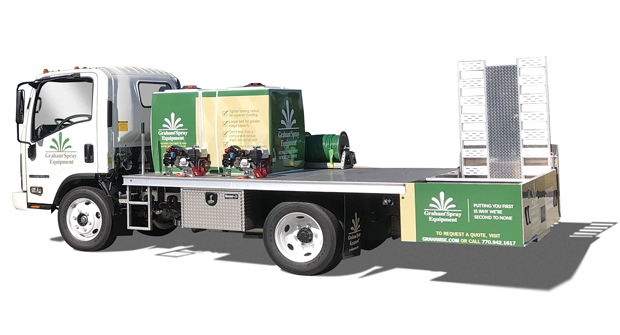
Performing maintenance on a spray rig may not be what drives your lawn care company’s revenue — and can feel like a chore — but there is every reason to be diligent about it.
Daily and seasonal maintenance keeps spray equipment functioning at peak performance and extends the life of the spray rig and its components. It also reduces the likelihood of expensive repairs and lost revenue due to downtime.
Daily maintenance checks
Performing key tasks and checks each morning is the best way to catch problems early and ensure the daily route goes smoothly and efficiently. Here are my top five tips for daily maintenance.
1. Clean the pump screen.
A dirty or clogged screen affects the flow rate. It also stresses the pump, which could damage it and shorten its lifespan. Clean the screen daily by removing it from its housing and spraying it with water to remove accumulated debris.

2. Do a bucket test to ensure a proper flow rate.
Ideally, when treating a lawn, a good reference point is to distribute 3 gallons of product per 1,000 square feet. A good approximation is a flow rate of 3 gallons per minute. A quick bucket test enables you to check the flow. After cleaning the screen, spray some product into a 1-gallon bucket and time how long it takes to fill. For a flow rate of 3 gallons per minute, it should take 20 seconds. If the time you get is off, adjust the flow.
3. Test the hose reel.
While you have the hose out (for the bucket test), it makes sense to test the reel. Pull a decent length of hose out and press the button on the reel to verify it works properly and this winds up the hose.
4. Check for loose belts.
The tension on the idlers is correct when 1/2 inch of spring is in the belts. Simply hand tighten any belts with more than 1/2 inch of spring. When you check the tension, look over the belts for cracks, dry rot and excessive wear and tear.
5. Hose off the rig.
Fertilizers and other chemicals are highly corrosive and will eventually eat through even aluminum. At the end of each day, spray down the rig to remove any chemical residue. Giving your rig a quick rinse is one of the best things you can do to ensure it lasts and looks good for a very long time.
Summertime maintenance
It’s tempting to cut corners during the busy summer season, but this is the time when rig maintenance is extra important to prevent downtime. Here are my top three tips for rig maintenance in the summer.
1. Check the oil, spark plugs and air filter regularly.
This may seem obvious, but it’s worth emphasizing. A quick check of these three things can spare you some potentially major problems.
2. Take inventory of replacement parts.
Many routine rig repairs — such as replacing a worn belt — are easy enough to do yourself. Make sure you have common replacement parts and repair kits on hand.
3. Wash your rig weekly.
Along with a daily hosing-off, a weekly wash goes a long way to extending the useful life of your rig.
Winterize your rig
If you’re in a climate where winter is an offseason, it’s important to winterize your rig to prevent damage due to freezing and corrosion. The process is just a few simple steps.
These include:
- Remove strainer caps and screens.
- Open ball valves on suction lines.
- Remove nozzles from spray guns and fix the trigger in the open position.
- Remove the plug or open the drain valve on the regulator.
- Open valves on reels and tanks, including the drop valve.
- Turn the pump over to completely drain it.
To get your rig ready in the spring, reverse the process. By incorporating these maintenance recommendations into your daily and seasonal routines, both your spray rig and your business will run much smoother.

